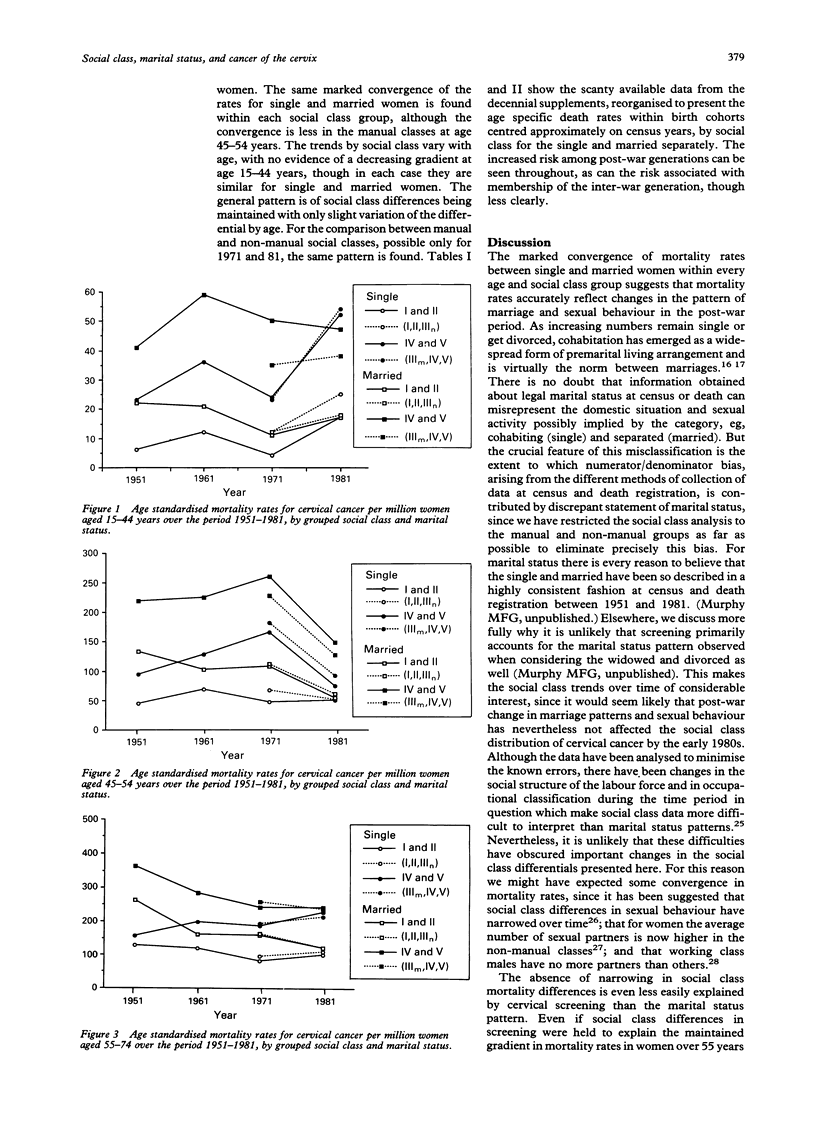Abstract
STUDY OBJECTIVE--The aim was to investigate whether trends in mortality from cancer of the cervix uteri by age, marital status, and social class are compatible with current beliefs about the epidemiology of the disease. DESIGN--Data on mortality from cancer of the cervix for single and married women by age and social class were obtained from the Registrar General's Decennial Supplements on occupational mortality for the years 1950-53, 1959-63, 1970-72, and 1979, 1980, 1982, and 1983. Age standardised mortality rates were calculated directly by social class and marital status. SETTING--The data relate to all cases of carcinoma of the cervix reported in England and Wales in the years studied. MAIN RESULTS--There was a marked convergence of mortality between single and married women over the period within every social class grouping examined. The social class differential, however, remained essentially unchanged for both single and married women considered separately. CONCLUSIONS--Trends in mortality by marital status appear to reflect accurately the changes in the pattern of marriage and sexual behaviour that have taken place in the post-war period, whereas the patterns of other risk and protective factors such as screening explain these trends less well. In contrast, it seems likely that factors other than patterns of sexual behaviour and screening operate to maintain the social class differential in England and Wales.
Full text
PDF



Selected References
These references are in PubMed. This may not be the complete list of references from this article.
- Beral V. Cancer of the cervix: a sexually transmitted infection? Lancet. 1974 May 25;1(7865):1037–1040. doi: 10.1016/s0140-6736(74)90432-2. [DOI] [PubMed] [Google Scholar]
- Brinton L. A., Hamman R. F., Huggins G. R., Lehman H. F., Levine R. S., Mallin K., Fraumeni J. F., Jr Sexual and reproductive risk factors for invasive squamous cell cervical cancer. J Natl Cancer Inst. 1987 Jul;79(1):23–30. [PubMed] [Google Scholar]
- Brinton L. A., Huggins G. R., Lehman H. F., Mallin K., Savitz D. A., Trapido E., Rosenthal J., Hoover R. Long-term use of oral contraceptives and risk of invasive cervical cancer. Int J Cancer. 1986 Sep 15;38(3):339–344. doi: 10.1002/ijc.2910380307. [DOI] [PubMed] [Google Scholar]
- Brinton L. A., Reeves W. C., Brenes M. M., Herrero R., de Britton R. C., Gaitan E., Tenorio F., Garcia M., Rawls W. E. Parity as a risk factor for cervical cancer. Am J Epidemiol. 1989 Sep;130(3):486–496. doi: 10.1093/oxfordjournals.aje.a115362. [DOI] [PubMed] [Google Scholar]
- Brinton L. A., Tashima K. T., Lehman H. F., Levine R. S., Mallin K., Savitz D. A., Stolley P. D., Fraumeni J. F., Jr Epidemiology of cervical cancer by cell type. Cancer Res. 1987 Mar 15;47(6):1706–1711. [PubMed] [Google Scholar]
- Brown S., Vessey M., Harris R. Social class, sexual habits and cancer of the cervix. Community Med. 1984 Nov;6(4):281–286. [PubMed] [Google Scholar]
- Catterall R. D. Biological effects of sexual freedom. Lancet. 1981 Feb 7;1(8215):315–319. doi: 10.1016/s0140-6736(81)91921-8. [DOI] [PubMed] [Google Scholar]
- Charny M. C., Lewis P. A. Who is using cervical cancer screening services? Health Trends. 1987 Nov;19(4):3–5. [PubMed] [Google Scholar]
- Coulter A., Baldwin A. Survey of population coverage in cervical cancer screening in the Oxford region. J R Coll Gen Pract. 1987 Oct;37(303):441–443. [PMC free article] [PubMed] [Google Scholar]
- Coulter A., McPherson K. Socioeconomic variations in the use of common surgical operations. Br Med J (Clin Res Ed) 1985 Jul 20;291(6489):183–187. doi: 10.1136/bmj.291.6489.183. [DOI] [PMC free article] [PubMed] [Google Scholar]
- Forman D., Chilvers C. Sexual behaviour of young and middle aged men in England and Wales. BMJ. 1989 Apr 29;298(6681):1137–1142. doi: 10.1136/bmj.298.6681.1137. [DOI] [PMC free article] [PubMed] [Google Scholar]
- Harris R. W., Brinton L. A., Cowdell R. H., Skegg D. C., Smith P. G., Vessey M. P., Doll R. Characteristics of women with dysplasia or carcinoma in situ of the cervix uteri. Br J Cancer. 1980 Sep;42(3):359–369. doi: 10.1038/bjc.1980.246. [DOI] [PMC free article] [PubMed] [Google Scholar]
- Harris R. W., Forman D., Doll R., Vessey M. P., Wald N. J. Cancer of the cervix uteri and vitamin A. Br J Cancer. 1986 May;53(5):653–659. doi: 10.1038/bjc.1986.109. [DOI] [PMC free article] [PubMed] [Google Scholar]
- Kiernan K. E. The British family: contemporary trends and issues. J Fam Issues. 1988 Sep;9(3):298–316. doi: 10.1177/019251388009003002. [DOI] [PubMed] [Google Scholar]
- Mant D., Vessey M., Loudon N. Social class differences in sexual behaviour and cervical cancer. Community Med. 1988 Feb;10(1):52–56. doi: 10.1093/oxfordjournals.pubmed.a042379. [DOI] [PubMed] [Google Scholar]
- Marmot M. G., McDowall M. E. Mortality decline and widening social inequalities. Lancet. 1986 Aug 2;2(8501):274–276. doi: 10.1016/s0140-6736(86)92085-4. [DOI] [PubMed] [Google Scholar]
- Milner P. C., Watts M. Effect of socioeconomic status on survival from cervical cancer in Sheffield. J Epidemiol Community Health. 1987 Sep;41(3):200–203. doi: 10.1136/jech.41.3.200. [DOI] [PMC free article] [PubMed] [Google Scholar]
- Murphy M., Goldblatt P., Thornton-Jones H., Silcocks P. Survival among women with cancer of the uterine cervix: influence of marital status and social class. J Epidemiol Community Health. 1990 Dec;44(4):293–296. doi: 10.1136/jech.44.4.293. [DOI] [PMC free article] [PubMed] [Google Scholar]
- Murphy M., Osmond C. Predicting mortality from cancer of the uterine cervix from 1991-2001. J Epidemiol Community Health. 1992 Jun;46(3):271–273. doi: 10.1136/jech.46.3.271. [DOI] [PMC free article] [PubMed] [Google Scholar]
- Muñoz N., Bosch F. X. Epidemiology of cervical cancer. IARC Sci Publ. 1989;(94):9–39. [PubMed] [Google Scholar]
- Palan P. R., Romney S. L., Mikhail M., Basu J., Vermund S. H. Decreased plasma beta-carotene levels in women with uterine cervical dysplasias and cancer. J Natl Cancer Inst. 1988 May 18;80(6):454–455. doi: 10.1093/jnci/80.6.454. [DOI] [PubMed] [Google Scholar]
- Pugh H., Power C., Goldblatt P., Arber S. Women's lung cancer mortality, socio-economic status and changing smoking patterns. Soc Sci Med. 1991;32(10):1105–1110. doi: 10.1016/0277-9536(91)90086-r. [DOI] [PubMed] [Google Scholar]
- Skegg D. C., Corwin P. A., Paul C., Doll R. Importance of the male factor in cancer of the cervix. Lancet. 1982 Sep 11;2(8298):581–583. doi: 10.1016/s0140-6736(82)90661-4. [DOI] [PubMed] [Google Scholar]
- Winkelstein W., Jr Smoking and cervical cancer--current status: a review. Am J Epidemiol. 1990 Jun;131(6):945–960. doi: 10.1093/oxfordjournals.aje.a115614. [DOI] [PubMed] [Google Scholar]


